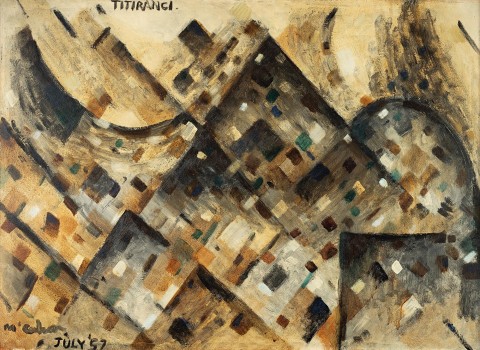TITIRANGI, 1957
COLIN McCAHON
oil on cardboard
55.0 x 75.5 cm
signed and dated lower left: McCahon / JULY ’57
inscribed with title upper left: TITIRANGI.
Rodney Kirk Smith, Auckland, New Zealand
Ray Hughes, Sydney, acquired from the above c.1987
Estate of Ray Hughes, Sydney
probably: The Group Show, Durham Street Art Gallery, Christchurch, New Zealand, 12 – 27 October 1957
probably: Recent Paintings, Dunedin Public Library, Dunedin, New Zealand, 1 – 18 April 1958
Eight New Zealand Painters III, Auckland City Art Gallery, Auckland, New Zealand, October – November 1959, cat. 19
Bloem, M., and Browne, M., Colin McCahon A Question of Faith, Stedelijk Museum, Amsterdam, Craig Potton Publishing, 2002, pp. 254 – 255
Simpson, P., Colin McCahon There is Only One Direction 1919 – 1959, Auckland University Press, Auckland, New Zealand, 2019, pp. 324, 325
Colin McCahon Online Catalogue, ref. cm001390 [http://www.mccahon.co.nz/cm001390] (accessed 10/03/20)
Colin McCahon clearly valued Titirangi, 1957 highly since he chose it as one of the five works to represent his career to date (a kind of mini-retrospective) in the exhibition Eight New Zealand Painters III at Auckland City Art Gallery in 1959. It was the most recent work in his selection, the others dating from 1946, 1947, 1950 and 1955. Though provided with a place name as title, it was the most abstract of the works selected and represented his steady move towards abstraction throughout the 1950s.
If ‘Titirangi’ is entered into the search engine of the Colin McCahon Online catalogue (www.mccahon.co.nz) around 40 works come up, ranging in date from 1953 through to 1959 – precisely the period in which McCahon and his family lived in the bush suburb of Titirangi on the hilly western outskirts of Auckland City. The bare title Titirangi is shared with five other works, all from the period 1956 – 57. They are a ‘family’ cluster of works, other connected clusters from the same period being ‘Kauri’, ‘Manukau’ and ‘French Bay’.
Most of the works with ‘Titirangi’ in their titles are studies of the bush environment – predominantly regenerating kauri, a massive ancient coniferous tree, but also including other species such as kahikatea (white pine) and the palm-like nikau – which surrounded the McCahons’ dwelling in French Bay, Titirangi. The bush was a subject of endless fascination for McCahon as a painter, ranging from depictions of individual trees or groups of trees – Kauri Trees, Titirangi, 1955 – 57 (Private collection)1 – to generalised studies of the bush as a mass of vegetation – Titirangi, 1956 – 57 (collection of Auckland Art Gallery Toi o Tāmaki).2 These works are arrayed along a spectrum ranging from simple realism at one end to complete abstraction at the other. Broadly speaking, though there are exceptions, as time passed the approach became increasingly abstract, with the present work close to the non-representational end of the scale. Others with a similar degree of abstraction included Red Titirangi, 1957 (private collection, Auckland)3, painted in the same month of July 1957. Of these works McCahon commented: ‘In 1957 too, a great change in attitude to the Titirangi landscape … I came to grips with the kauri and turned him in all his splendour into a symbol’.4
Titirangi is dominated by a roughly diagonal grid which divides the surface of the picture into large diamond-shaped blocks. Such grids were part of McCahon’s Cubist-inspired efforts to unify a picture while escaping traditional perspective. Running counter to this pattern are concave and convex shapes at upper left and right – which might be read as clouds or the profiles of kauri trees – and a horizontal and vertical form at lower right, constituting a rough square which might be read as a building. Within these broader outlines are numerous small lozenges of colour typical of works of this period – white, pink, ochre, brown, black – and other expressive marks. Painted with great energy and dynamism, the picture references sky, clouds, buildings, a tree line and other such details, however the overall effect is of an abstract painting which relates to the specifics of a particular locality but subsumes these within a fundamentally non-representational impression.
1. Colin McCahon Online catalogue [www.mccahon.co.nz], cat. cm000407
2. Colin McCahon Online catalogue [www.mccahon.co.nz], cat. cm001386
3. Colin McCahon Online catalogue [www.mccahon.co.nz], cat. cm001580
4. McCahon, C., quoted in Colin McCahon: A Survey Exhibition, Auckland City Art Gallery, Auckland, New Zealand, 1972, p. 24
PETER SIMPSON
